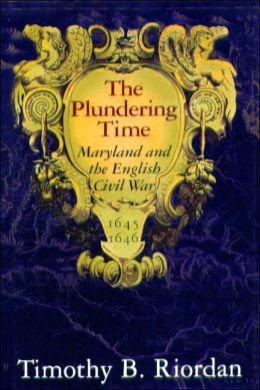I just finished reading The Plundering Time: Maryland and the English Civil War, 1645-1646 by Timothy B. Riordan. It tells the story of years of conflict that almost destroyed the British colony in Maryland.
The first colonial settlement in what is now Maryland was in Kent Island in 1631, as part of colonial Virginia. A charter was given to Cecil Calvert Lord Baltimore in 1632 for the Maryland colony. Riordan states that the charter was granted (over the objections of Virginia) because the British government felt Baltimore's proposed colony would be the best available option to counter Dutch and Swedish colonies in Delaware. Led by Leonard Calvert, Cecil Calvert's younger brother, the first group of colonists consisted of 17 gentlemen and their wives, and about two hundred others, mostly indentured servants arrived in Maryland in March 1634. They established a town at St. Marys. In 1838, led by Calvert, the colonists seized the trading post at Kent's Island.
The 17th century was a turbulent time in Britain. The English Civil War between Royalists and supporters of Parliament took place between 1642 and 1651. Under the Stuart kings, James I and Charles I, in the early part of the century the country had grave economic problems. There were battles internal to the Anglican church as to its governance and role in society, with Catholics and Puritans dealing with institutionalized prejudice. In the wake of the European exploitation of the Americas, the Reformation and the Counter Reformation, turmoil roiled the European continent. Britain was threatened with both religious and political wars, and foreign policy was central to domestic political disputes. It was in this context that British colonies in North America were established.
The Calverts intended to establish a colony on a manorial structure. Catholics themselves, they made an effort to include both Protestants and Catholics in the settlement. The intent was that the colony would abide by British laws. Leonard Calvert was named governor of the colony and a committee of five gentlemen was established as a legislative body. Judicial processes were established (and the records of the judicial proceedings, assembly and governor provide much of the evidence discussed in Riordan's book). However, the Calverts also invited Jesuit missionaries to bring Christianity to the Maryland Indians at a time when Jesuits found in England would be executed.
Establishing a new colony in North America was hard! The Maryland colony was to pay for itself by growing tobacco and exporting it to Britain. The colonists could also trade with Indians for furs which could be exported. Colonists were also to grow corn and raise livestock to support themselves, but were heavily dependent on materials imported from England. The voyage from England to Maryland took from 8 to 10 weeks as did the return voyage; a single tobacco fleet was sent each year carrying trade goods to Maryland and returning with its tobacco harvest; remember the ships of the day were small and the voyage dangerous. All this to be done by Europeans with few skills to deal with the new land, subject to the climate and illnesses they found there with few protections. Colonists in the 17th century were also under threat from Indians (who had survived the decimation of the Colombian Exchange) whose territory they were occupying. Still, by the early 1640s the immigrant population of the Maryland colony numbered about 800, most of whom were men. They were concentrated in three areas.
As the English Civil War broke out, the Royalists issued a letter of marque to the Calverts allowing their ships to attack ships and ports supporting the Parliamentary side and take their property, while Parliament issued a letter of marque to Richard Ingle, a hot tempered ship captain who had traded in the Chesapeake for some years.
Ingle recruited the crew of his ship, some Virginians and some Protestant Maryland colonists and attacked and captured a couple of ships and then began to plunder Catholic households in the Maryland colony. The supporters of the Calverts fought back. Both sides build forts for protection (and presumably as bases for their attacks on the other). Within a couple of years most of the colonists had died or moved away and the economy of the colony was in tatters.
Still, the Calverts were able to recruit forces to retake the colony and reestablish its government. The population was quickly rebuilt, in part by recruiting Independent Protestant (those not affiliated with the Church of England) settlers from Virginia (where they were subject to persecution). The Puritan faction would create their own crisis later in the century.
The rebuilt colony was then governed by Protestants rather than Catholics, freemen rather than gentlemen. Moreover, it established a policy under which people were to be allowed to follow their own religious beliefs and not bound to a state religions -- an important precedent.
I found the book too academic for my interests. After all, it deals with conflict within a population of fewer than 800 people centuries ago. Indeed the people involved seem to be very litigious and not very likable. Riordan argues for interpretations of events, citing existing textual records from the time extensively, An archaeologist, he also cites the results of his own archaeological research. All of this is important for his fellow historians, but I was more interesting in the simple fact that the English Civil War had an impact in the early days of the Maryland colony that almost destroyed it.

No comments:
Post a Comment